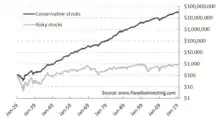Conservative Formula Investing
Conservative formula investing is a low-volatility investing approach enhanced with net payout yield and momentum.
Methodology
The formula is based on 3 investment criteria: Low risk, income and trend. First, the 1,000 largest stocks are divided into two groups based on their historical 36-month stock return volatility. Second, each stock in the low volatility group is ranked on its 12-1 month price momentum and net payout yield. Third, the momentum and yield ranks (1-500) are simply averaged and the 100 best stocks are equally weighted in a final portfolio. Rebalancing takes place on a quarterly basis.
Code to replicate the investment formula is shared on Reddit and Medium.[1][2] The formula is designed to make factor investing easy for investors and is introduced in the investment book 'High Returns from Low Risk'.[3] This low-volatility investing book is translated into Chinese, German, French, Spanish and Dutch.[4][5][6][7][8] The formula has been scientifically tested in a Journal of Portfolio Management study and a study is publicly available on SSRN.[9][10]
Results
The Conservative formula is tested going back to 1929 for the US and is also tested for Europe, Japan and Emerging Markets and also China.[11] The average annualized return is 15.1% per annum, outperforming the broad market index by a wide margin and achieved with lower risk (US 1929–2016).[9] Deep historical return series can be downloaded going back to 1929.[12] The image shows the cumulative dollar performance the Conservative Formula over time.

Coverage and use
The investment formula gives investors exposure to multiple investment factors utilizing easy to obtain data. Alpha architect writes: "While achieving the goals of simplicity and liquidity the conservative formula gives positive factor tilts towards low-beta, value, quality, and momentum."[13] The formula has been discussed on GuruFocus.com, La Vanguardia Financial Investigator, ETF guru and reviewed on JD.com.[14][15][16][4] It is included as a stock screener on Validea and ValueSignals.[17][18]
References
- mementix (2018-04-26). "The Conservative Formula in Python: Quantitative Investing made Easy". r/algotrading. Retrieved 2022-01-08.
- Rodriguez, Daniel (2019-08-29). "Rebalancing with the Conservative Formula". Medium. Retrieved 2022-01-08.
- "High Returns from Low Risk: A Remarkable Stock Market Paradox | Wiley". Wiley.com. Retrieved 2022-01-08.
- "《低风险,高回报 一个引人注目的投资悖论 中信出版社》([荷]平·范·弗利特(Pim van Vliet) [荷]杨·德·科宁(Jan de Konin))【摘要 书评 试读】- 京东图书". item.jd.com. Retrieved 2022-01-08.
- Finanz Buch Verlag - Der Weg zum eigenen stabilen Aktien-Portfolio (in German). 2017-01-23. ISBN 978-3-95972-020-5.
- "Livre Un paradoxe financier étonnant - Economica - Finance". www.economica.fr. Retrieved 2022-01-08.
- El pequeño libro de los altos rendimientos con bajo riesgo - Pim Van Vliet,Jan de Koning | PlanetadeLibros (in European Spanish).
- "Atlas Contact De conservatieve belegger - Pim van Vliet, Jan de Koning : Atlas Contact". www.atlascontact.nl. Retrieved 2022-01-08.
- Blitz, David; Vliet, Pim van (2018-07-31). "The Conservative Formula: Quantitative Investing Made Easy". The Journal of Portfolio Management. 44 (7): 24–38. doi:10.3905/jpm.2018.44.7.024. ISSN 0095-4918.
- "Social Science Research Network - SSRN".
- Pong, Eddie (2019-02-18). "Conservative Equity Investing". Rivermap. Retrieved 2022-01-08.
- "Low-volatility data free available for download". Low-volatility and Conservative Formula return series. Archived from the original on 2019-12-05. Retrieved 2022-01-08.
- "Alpha Architect Review: The Conservative Formula: Quantitative Investing made Easy". Alpha Architect. 2018-09-11. Archived from the original on 2020-08-12. Retrieved 2022-01-08.
- "High Returns From Low Risk: Th - GuruFocus.com". www.gurufocus.com. Retrieved 2022-01-08.
- "Aprender a invertir: máxima rentabiliad y mínimo riesgo". La Vanguardia (in Spanish). 2019-09-19. Retrieved 2022-01-08.
- "ETF guru | Swedroe explaining low-volatility". Archived from the original on 2015-02-14.
- "Multi Factor Investing Strategy and Portfolio - Validea.com". www.validea.com. Archived from the original on 2019-06-26. Retrieved 2022-01-08.
- "Stock Screener". www.valuesignals.com. Retrieved 2022-01-08.